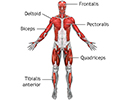Muscle disorder
Myopathic changes; Myopathy; Muscle problem
A muscle disorder includes patterns of weakness, electromyogram (EMG) findings, or biopsy results that suggest a muscle problem. The muscle disorder can be inherited, such as muscular dystrophy , or acquired, such as alcoholic myopathy.
Muscular dystrophy
Muscular dystrophy is a group of inherited disorders that cause muscle weakness and loss of muscle tissue, which get worse over time.

The medical name for muscle disorder is myopathy.
Symptoms
The main symptom is weakness.
Other symptoms include cramps and stiffness.
Exams and Tests
Blood tests sometimes show abnormally high muscle enzymes. If a muscle disorder might also affect other family members, genetic testing may be done.
When someone has symptoms and signs of a muscle disorder, tests such as an
electromyogram
,
muscle biopsy
, or both can confirm whether it is a myopathy. A muscle biopsy examines a tissue sample under a microscope to confirm disease. Sometimes, a blood test to check for a genetic disorder is all that is needed based on someone’s symptoms and family history.
Electromyogram
Electromyography (EMG) is a test that checks the health of the muscles and the nerves that control the muscles.

Muscle biopsy
A muscle biopsy is the removal of a small piece of muscle tissue for examination.

Treatment
Treatment depends on the cause. It usually includes:
- Bracing
- Medication
- Physical therapy
- Preventing the condition from getting worse by treating the underlying condition causing the muscle weakness
- Surgery (sometimes)
Your health care provider can tell you more about your condition and treatment options.
References
Borg K, Ensrud E. Myopathies. In: Frontera WR, Silver JK, Rizzo TD Jr, eds. Essentials of Physical Medicine and Rehabilitation: Musculoskeletal Disorders, Pain, and Rehabilitation. 3rd ed. Philadelphia, PA: Elsevier Saunders; 2015:chap 135.
Selcen D. Muscle diseases. In: Goldman L, Schafer AI, eds.
Goldman's Cecil Medicine.
25th ed. Philadelphia, PA: Elsevier Saunders; 2016:chap 421.
-
Superficial anterior muscles - illustration
Superficial muscles are close to the surface of the skin. Muscles which lie closer to bone or internal organs are called deep muscles.
Superficial anterior muscles
illustration
Review Date: 1/5/2016
Reviewed By: Joseph V. Campellone, MD, Division of Neurology, Cooper University Hospital, Camden, NJ. Review provided by VeriMed Healthcare Network. Also reviewed by David Zieve, MD, MHA, Isla Ogilvie, PhD, and the A.D.A.M. Editorial team.

